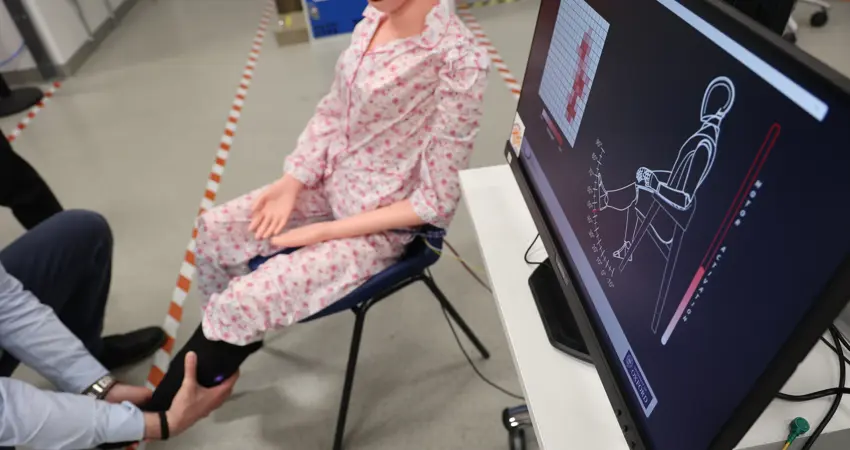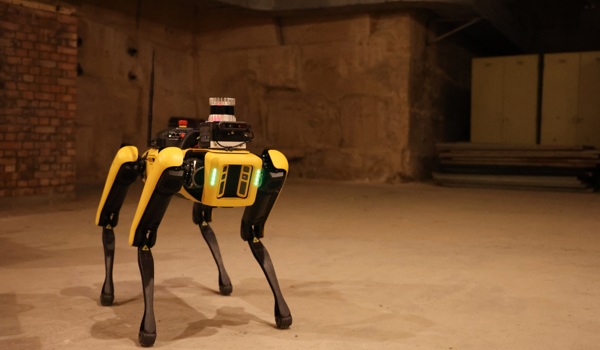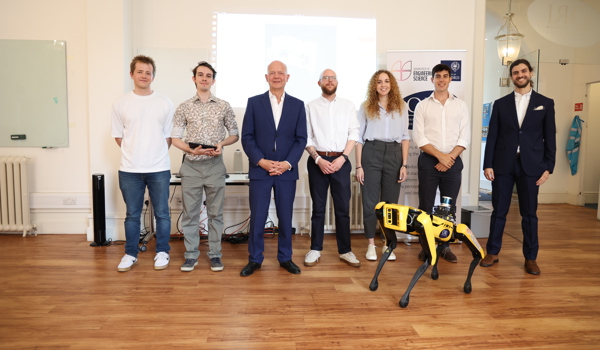13 Sep 2024
Robots being used to help research the importance of touch
Occupational therapists from Oxfordshire County Council’s adult social care team are working with experts from the Oxford Robotics Institute and University College London, on innovative research which uses robots to take the place of a person being assessed

Robots are being used in Oxfordshire as a training tool for the council’s occupational therapists, helping them to gain a greater understanding of the impact of touch during physical and seated assessments.
The groundbreaking work will offer a greater understanding about the way different people experience being touched and manoeuvred
Occupational therapists from Oxfordshire County Council’s adult social care team are working with experts from University College London (UCL) and the Oxford Robotics Institute (ORI), on innovative research which uses robots to take the place of a person being assessed, programmed to take on different life-like characteristics and health concerns.

The groundbreaking work will offer a greater understanding about the way different people experience being touched and manoeuvred, helping occupational therapists to develop their skills and improve assessments for residents.
Understanding more about the way their touch impacts the people they support can have significant benefits for both the resident and occupational therapist
Councillor Tim Bearder, Oxfordshire County Council’s Cabinet Member for Adult Social Care, says, “Our occupational therapists play an important role in our Oxfordshire Way vision by supporting people to live well and independently within their own homes."
“We’ve had an opportunity to work with world renowned institutions, giving our occupational therapists access to innovative technology that gives them greater confidence in how they carry out their vital work and supports our residents to have a better experience during physical assessments.”
Occupational therapy is an important role within adult social care. Occupational therapists are often the first people to come into contact with residents who need additional support from the council to live well in their own homes.
Their varied and multi-skilled role enables them to make important initial assessments about how a person is experiencing physical and cognitive challenges. They can also recommend improvements within their homes to help support them to continue to live independently.
The research by UCL and ORI also aims to look at how touch can be used as an effective method of non-verbal communication to soothe a patient or convey support
An important part of the assessment happens through physical interactions to assess a patient’s mobility and posture. Understanding more about the way their touch impacts the people they support can have significant benefits for both the resident and occupational therapist.
In addition to this, the research by UCL and ORI also aims to look at how touch can be used as an effective method of non-verbal communication, something known as ‘affective touch’, to soothe a patient or convey support.
Nadia Berthouze, Professor in Affective Computing and Interaction at UCL, says, "We are adopting a user-centred approach in designing this innovative technology, collaborating closely with occupational therapists to ensure the solution is tailored to their needs and enhances training effectiveness."
The data provides a way of measuring and capturing nuanced, hard to describe interactions, with the goal of improving the occupational therapy training process
Funded by the Engineering and Physical Sciences Research Council through the Embodied Intelligence: From Sensing to Collaboration programme grant, experts at UCL and ORI have built a robot and accompanying software with an array of sensors, capable of recreating a patient’s physical health profile and behaviour, to provide standardised training platforms for the occupational therapists.
By capturing this occupational therapist-patient interaction in a more scientific way, the data provides a way of measuring and capturing nuanced, hard to describe interactions, with the goal of improving the occupational therapy training process overall.
The development of a robotic platform, capable of precisely capturing very gentle, as well as more forceful interactions, while providing a realistic feel and semblance, has required the use of state-of-the-art technology
The programme has been running for two years, from the initial objectives around further understanding the role of touch, to the most recent development of a mannequin-like robot. This can be programmed to simulate various medical conditions such as arthritis and dementia.
Perla Maiolino, Associate Professor of Engineering Science at the Oxford Robotics Institute, says, “The development of a robotic platform, capable of precisely capturing very gentle, as well as more forceful interactions, while providing a realistic feel and semblance, has required the use of state-of-the-art technology for sensing, actuation and control. The ability of the sensors to respond quickly to small touch features challenging requirements of the application, which are crucial for correctly estimating contact area and, in future, performing gesture recognition."
“The ability to easily alter every control parameter, including sensitivity to pain in the sensorised areas, makes the robot a versatile and adaptable training tool for rapidly and accurately testing different scenarios, while also maintaining repeatability”, she adds.
The ultimate scientific goal of the programme is to create robots that can better collaborate with humans for a better, more-sustainable future
The robot mannequin is now ready to be used by occupational therapists, and will be used as a training platform. During this time, it will gather important information on the use of functional and affective touch, which will be analysed by the experts at UCL and the ORI to further develop the ability of the robots to accurately replicate patient’s real life conditions.
The ultimate scientific goal of the programme is to understand the more nuanced uses of the sense of touch, which is the first sense to develop in newborn babies, to create robots that can better collaborate with humans for a better, more-sustainable future.



